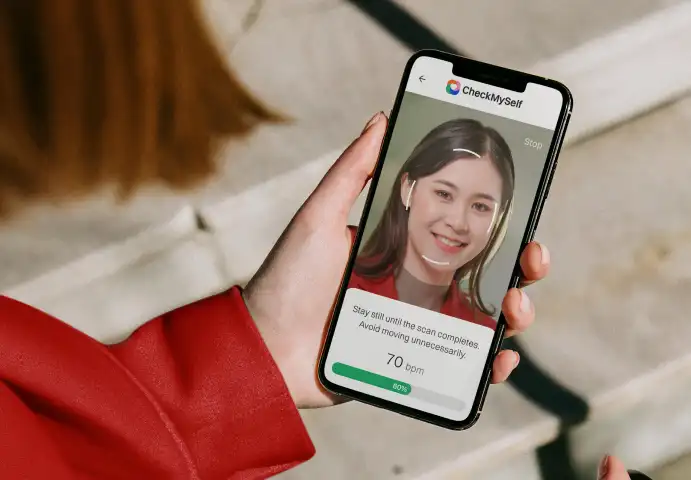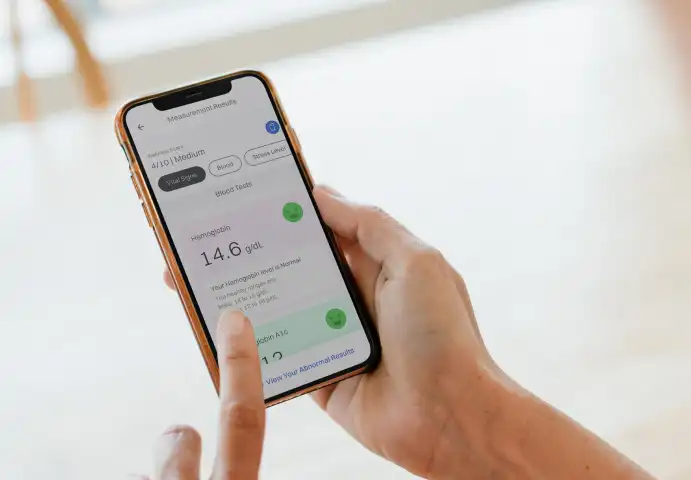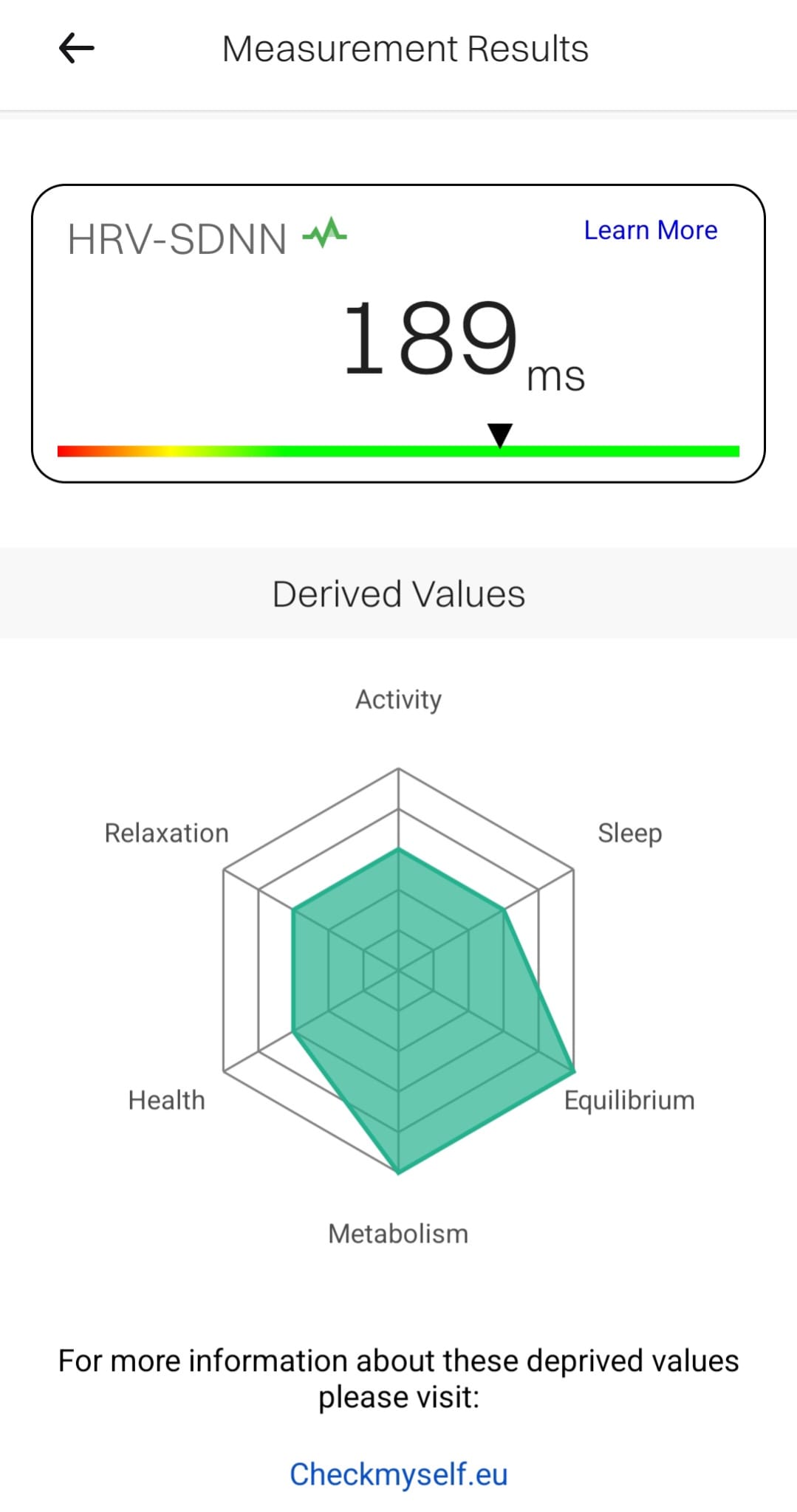Background Information
This page provides a comprehensive explanation of the technology, accuracy, and benefits of CheckMySelf. Discover how you can easily measure your vital signs and improve your health with this app.

This page provides a comprehensive explanation of the technology, accuracy, and benefits of CheckMySelf. Discover how you can easily measure your vital signs and improve your health with this app.

It is the only app in the world that operates with remote photoplethysmography (rPPG) and has received FDA 510(k) Clearance. The U.S. Food and Drug Administration (FDA) is globally recognized as the gold standard for testing and approving new drugs, food safety, and medical devices. When the FDA says something is safe and accurate, you can trust that it meets the strictest standards.
This means that the results (derived from heart rate) displayed by CheckMySelf have the same reliability and accuracy as those of professionally validated medical equipment.


Powered by FaceHeart, the technology behind CheckMySelf uses advanced AI to quickly and accurately analyze your vital signs. This is not a simple gimmick – it’s technology you can trust, backed by the strictest tests and approvals.
With CheckMySelf, you get more than just convenience; you get peace of mind. You know you can monitor your health with the same precision as at the doctor’s office or in a hospital, but without the cost or hassle of doctor visits. For just €2.95 per month or €30 (Android) per year, you bring the power of medical technology into your home – right to your phone.
Why settle for less when you can have the best? CheckMySelf is the only app that offers the assurance of FDA-approved accuracy. Start today and experience the difference for yourself. Health in your hand, with the quality you deserve.
Remote photoplethysmography (rPPG) uses reflected ambient light to measure subtle changes beneath the skin of the human face. It uses the color image of the human face captured by the camera to perform independent component analysis (ICA) on the RGB (Red, Green, Blue) three-channel signals and restores the perceived signal to a clean original signal.

1.Light shines on your skin: The lens of your camera captures the light through your skin.
2.Capturing the light: Some of this light is reflected or absorbed by your blood vessels. Each time your heart beats, the amount of blood in your capillaries changes, causing the amount of reflected light to change as well.
3.Measuring changes:
The camera captures these changes in light and converts them into a signal that indicates how your heart is beating.
4.AI (artificial intelligence) analyzes the data: The AI in the app processes these signals and can extract various information from them. In addition to your heart rate, the AI can also calculate your blood pressure, blood oxygen level, breathing rhythm, and even your stress level.
Self-management means regularly monitoring your vital signs, such as blood pressure, heart rate, and stress levels. This helps you detect health problems early and intervene before they become more serious.
Self-management allows you to regularly monitor your vital signs, such as blood pressure, heart rate, and stress levels. This helps you detect health problems early and intervene before they become more serious.
By regularly checking your health, you can quickly notice changes in your body. This can help prevent conditions such as high blood pressure, diabetes, or heart disease by allowing you to take action in time.
Regular doctor visits and medical tests can be expensive. By monitoring your health yourself, you can reduce the frequency of these visits, saving money in the long run.
Self-management increases your awareness of how your lifestyle affects your health. This can motivate you to make healthier choices, such as eating better, exercising more, and getting enough sleep.
If you notice that certain values are outside the normal range, you can take immediate action (e.g., consult www.thuisarts.nl) or contact a doctor. This can be crucial in preventing complications.

When you track your health yourself, you have accurate data to share with your doctor. This makes it easier for them to diagnose and develop a treatment plan.
By actively engaging in your own health management, you feel more in control and less dependent on others. This can boost your confidence and reduce stress.
With self-management, you can tailor your healthcare to your specific needs and lifestyle. You can experiment with different habits and immediately see how they impact your health.
The measurement results are stored exclusively on your phone or tablet. However, you can email the results to a doctor, caregiver, or another person.

Seeing positive results, such as lower blood pressure or an improved heart rate, can motivate you to stick to healthy habits and further improve your lifestyle.
Ultimately, self-management leads to better overall health, benefiting your energy, mood, and lifespan. You feel better, live longer, and can participate more actively in life.
Self-management of your health not only offers practical benefits but also empowers you with the knowledge and tools to proactively improve your health.
The spider diagram shows the six health indicators of CheckMySelf. These are derived from Heart Rate Variability (HRV) measurements, which reflect variations in heart rhythm. These indicators, such as Low Frequency (LF), High Frequency (HF), and the LF/HF ratio, are updated in real-time based on current HRV values, giving users timely insight into their overall health and its key elements.
Activity
Level of mental energy. The higher the value, the fitter you are.
Sleep
Your sleep quality.
Balance
Overall health. The balance between the six health indicators.
Metabolism
Ability to boost your metabolism.
Health
The body's aging index.
Relaxation
Level of fatigue due to stress.

Your heart rate variability (HRV) provides valuable insights into your stress levels, recovery capacity and overall health. With the CheckMySelf app, you gain a clear view of this important health indicator.

The higher your SDNN Index, the better. A higher value means your autonomic nervous system is more flexible and your body adapts more easily to different situations. What constitutes a healthy SDNN Index depends on context and measurement duration, but general guidelines help you understand your score.
An SDNNI of 25 ms isn’t bad if temporary, but concerning if consistent.
preferably in the morning upon waking
energy levels, mood, sense of recovery
PRQ stands for the ratio between your heart rate and breathing rhythm. These two processes are closely connected and continuously influence each other. This is called respiratory sinus arrhythmia—a natural pattern where your heart rate speeds up when you inhale and slows down when you exhale.
When you breathe in, your lungs expand and chest pressure changes. This temporarily reduces vagus nerve activity, causing your heart rate to increase slightly.
When you exhale, your chest relaxes and vagus nerve activity increases, slowing your heart rate.
This natural interplay ensures efficient oxygen intake and shows that your autonomic nervous system is healthy and flexible.
Stress, fatigue, or certain conditions may reduce this variation. Breathing exercises or yoga can help slow your heart rate via the vagus nerve and calm your body.
Start monitoring your vital functions in just 60 seconds today. Download CheckMySelf now for free and discover how simple health can be.
